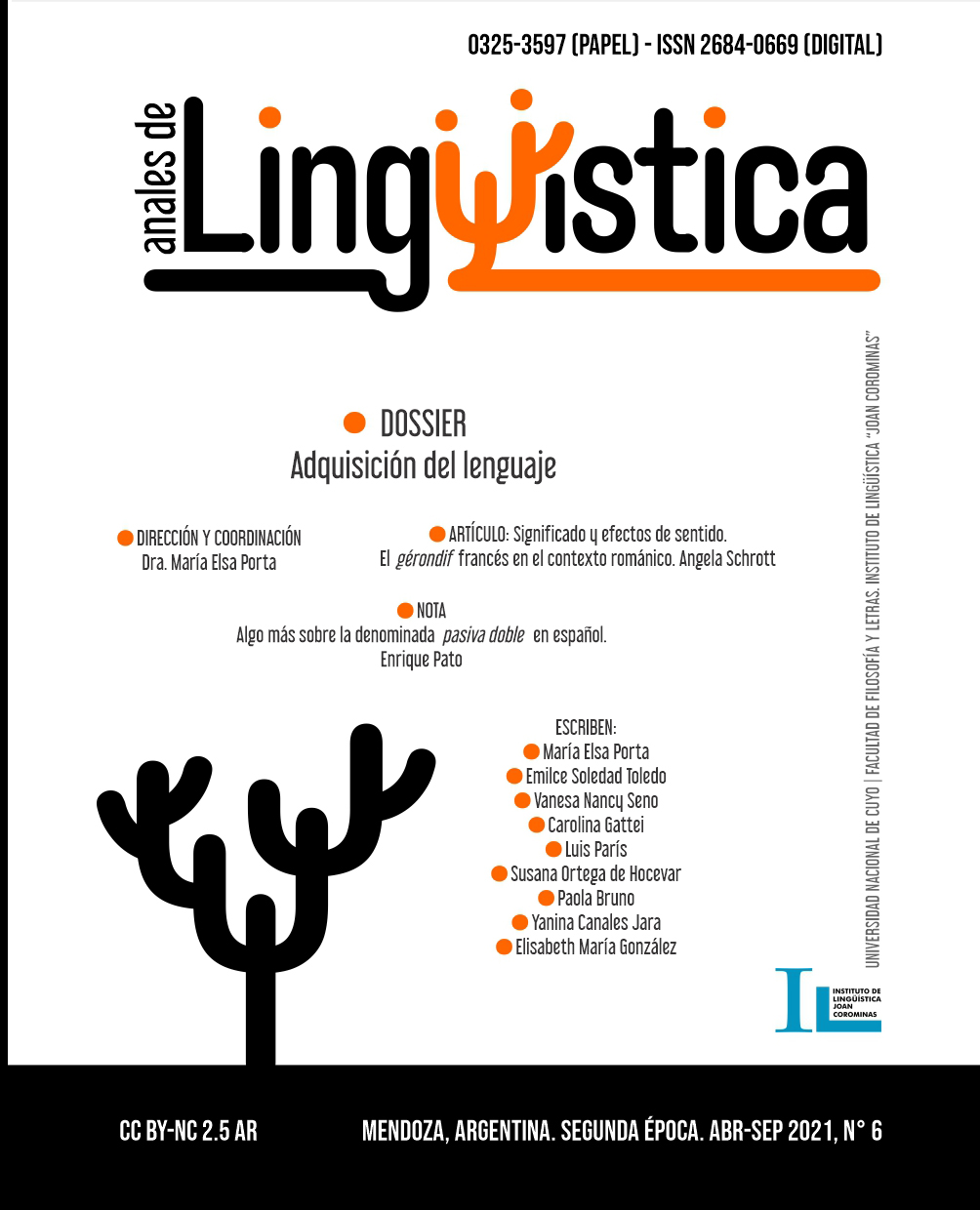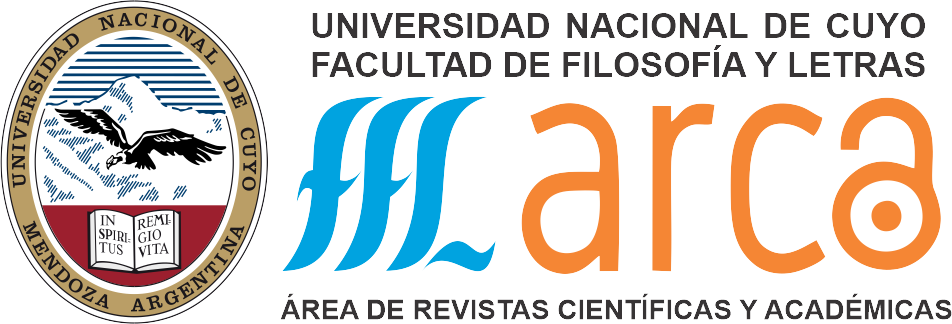Effects of a kindergarten phonological awareness and vocabulary intervention program on first grade reading achievement
Keywords:
Reading acquisition, Phonological awareness, Vocabulary, Early intervention, KindergartenAbstract
The phonological awareness ability is a key precursor of word reading. However, models on reading comprehension hold that more than one linguistic skill should be develop. This study evaluates the impact of two types of intervention (phonological awareness (PA) versus phonological awareness and vocabulary) delivered to kindergarten children from low socioeconomic status in their grade one reading level. We collected pre and post intervention measures on phonological awareness, vocabulary, word reading, and reading comprehension. The participants were children from 129 kindergarten who attended six classes from four urban-marginal schools from Mendoza, Argentina (Mean age, 66.2 months (5.5 aged), DT= 0.4). The children who received the combined intervention showed grater scores on vocabulary, reading, writing, and reading comprehension than the group who received the intervention on PA only. The intervention was more effective when PA was combined with vocabulary. The results have theoretical implications on the development of more comprehensive models about reading acquisition.
References
Al Otaiba, S., Kosanovich, M. L. y Torgesen, J. K. (2012). Assessment and instruction for phonemic awareness and word recognition skills. En: A.G. Kamhi, H. W. Catts (eds.). Language and reading disabilities (pp. 112-140). New York, NY: Pearson.
Arancibia, B., Bizama, M. y Sáez, K. (2012). Application of stimulation program of phonological awareness in pre-school children and first year elementary school students, who attend socially vulnerable schools in Concepción, Chile. Signos, 45(80), 236-256.
Beck, I. L., McKeown, M. G. y Kucan, L. (2013). Bringing words to life: Robust vocabulary instruction. New York: Guilford Press.
Biemiller, A. (2012). Teaching vocabulary in the primary grades: Vocabulary instruction needed. En: A. J. Kame’enui & J. F. Baumann (Eds.). Vocabulary instruction research to practice 2nd edition (pp. 34-50), NY: The Guildford Press.
Bizama, M., Arancibia, B. y Sáez, K. (2013). Intervención psicopedagógica temprana en CV como proceso metalingüístico a la base de la lectura en niños de 5 a 6 años socialmente vulnerables. Estudios Psicopedagógicos, 39(2), 25-39.
Blachman B., Ball E., Black R. y Tangel D. (2000). Road to the code. A phonological awareness program for young children. Baltimore, Maryland: Paul H. Brookes Publishing C.
Bonnes Bowne, J., Yoshikawa, H. y Snow, C. E. (2016). Experimental impacts of a teacher professional development program in early childhood on explicit vocabulary instruction across the curriculum. Early Childhood Research Quarterly, 34(1), 27-39.
Branum-Martin, L., Tao, S. y Garnaat, S. (2015). Bilingual phonological awareness: Reexamining the evidence for relations within and across languages. Journal of Educational Psychology, 107(1), 111-125.
Caravolas, M., Lervåg, A., Defior, S., Seidlová-Málková, G. y Hulme, C. (2013). Different patterns, but equivalent predictors, of growth in reading in consistent and inconsistent orthographies. Psychological Science, 24(8) 1398–1407. doi: 10.1177/095679 7612473122.
Caravolas, M., Lervåg, A., Mikulajova, M., Defior, S., Seidlová-Málková, G. y Hulme, C. (2019). A cross-linguistic, longitudinal study of the foundations of decoding and reading comprehension ability. Scientific Studies of Reading, 23(5), 386-402. doi: 10.1080/10888438.2019.1580284
Carlisle, J. (1995). Morphological awareness and early reading achievement. En: L. B. Feldman (Ed.). Morphological Aspects of Language Processing (pp. 189–209). Hillsdale, NJ: Erlbaum. doi: 10.4236/psych.2014.58103.
Casalis, S. y Colé, P. (2009). On the relationship between morphological and phonological awareness: Effects of training in kindergarten and in first-grade reading. First Language, 29, 113-142. doi: 10.1177/0142723708097484
Cunningham, A. E. y Stanovich, K. E. (1998). What reading does for the mind. American Educator, 22(Spring/Summer), 8–15.
Defior, S. (2008). ¿Cómo facilitar el aprendizaje inicial de la lectoescritura? Papel de las habilidades fonológicas. Infancia y Aprendizaje, 31, 333-345.
Defior, S. y Serrano, F. (2011). La conciencia fonémica, aliada de la adquisición lenguaje escrito. Revista de Logopedia, Foniatría y Audiología, 31(1), 2-13.
Gónzalez, L. Rodríguez, C. y Gázquez, J. (2011). Aproximación al concepto de conciencia morfológica: concepto, desarrollo y relación con la lectura y la escritura. Revista de Formación del Profesorado e Investigación Educativa, 135-146.
Gough, P. (1996). How children learn to read and why they fail. Annals of Dyslexia, 46, 3–20.
Deacon, S. H. y Kirby, J. R. (2004). Morphological Awareness: Just “More Phonological”? The Roles of Morphological and Phonological Awareness in Reading Development. Applied Psycholinguistics, 25, 223-238. doi.org/10.1017/S0142716404001110
Dunn, L. M., Padilla, E., Lugo, D. y Dunn, D.M. (1986). Test de Vocabulario en Imágenes Peabody: Adaptación Hispano-Americano. Circle Pines, MN. American Guidance Service.
Ehri, L., Nunes, S., Willows, D., Schuster, B., Yaghoub-Zadeh, Z. y Shanahan, T. (2001) Phonemic awareness instruction helps children learn to read: evidence from the national reading panel’s meta-analysis. Reading Research Quarterly, 36(3), 250-287.
Elleman, A. M., Lindo, E. J., Morphy, P. y Compton, D. L. (2009). The impact of vocabulary Instruction on passage-level comprehension of school-age children: A meta-analysis. Journal of Research on Educational Effectiveness, 2(1), 1–44.
Foorman, B., Beyler, N., Borradaile, K., Coyne, M., Denton, C. A., Dimino, J., Furgeson, J., Hayes, L., Henke, J., Justice, L., Keating, B., Lewis, W., Sattar, S., Streke, A., Wagner,
R. y Wissel, S. (2016). Foundational skills to support reading for understanding in kindergarten through 3rd grade (NCEE 2016-4008). Washington, DC: National Center for Education Evaluation and Regional Assistance (NCEE), Institute of Education Sciences, U.S. Department of Education. Recuperado de http://whatworks.ed.gov.
Gaskins, I. W., Ehri, L. C., Cress, C., O’Hara, C. y Donnelly, K. (1997). Procedures for word learning: Making discoveries about words. The Reading Teacher, 50, 312–327.
González, R. M., Cuetos, F., Vilar, J. y Uceira E. (2015). Efectos de la intervención en conciencia fonológica y velocidad de denominación sobre el aprendizaje de la escritura. Aula Abierta, 43 (1), 1-8.
Gutiérrez, R. (2016). La lectura dialógica como medio para la mejora de la comprensión lectora. Investigaciones Sobre Lectura, 5, 52-58.
Gutiérrez, R. y Díez, A. (2015). Aprendizaje de la escritura y habilidades de conciencia fonológica en las primeras edades. Bordón, 67(4), 43-59. doi: 10.13042/bordon.2015.67405
Herrera, L., Defior, S. y Lorenzo, O. (2007). Intervención educativa en conciencia fonológica en niños prelectores de lengua materna española y Tamazight. Comparación de dos programas de entrenamiento. Infancia y Aprendizaje, 30(1), 39- 54.
INDEC (20018). Indicadores de condiciones de vida de los hogares en 31 aglomerados urbanos. Indec, Segundo semestre 2018 (indec.gob.ar)
Jasińska, K. y Laura-Ann, P. (2017). Age of bilingual exposure is related to the contribution of phonological and semantic knowledge to successful reading development. Child Development, 89(1), 310-331.
Law, J. y Ghesquière, P. (2017). Early development and predictors of morphological awareness: Disentangling the impact of decoding skills and phonological awareness. Research in Developmental Disabilities, 17, 47-59.
Lyster, S. A. (2002). The effects of morphological versus phonological awareness training in kindergarten on reading development. Reading and Writing, 15, 261–294.
Lyster, S. A., Lervåg, A. y Hulme, C. (2016). Preschool morphological training produces long-term improvements in reading comprehension. Reading and Writing. 29, 1269– 1288.
Meneses, B. A. L., Garzón, M. A., Macías, J., Argüelles, P. D., Triana, M. C. y Rodríguez, E. C. (2012). Intervención en conciencia fonológica (CF) en el aula para niños de primer ciclo Cuadernos Hispanoamericanos, 12(2), 65-79.
Nagy, W. E. (2007). Metalinguistic awareness and the vocabulary- comprehension connection. En: R. Wagner, A. Muse, and K. Tannenbaum (Eds.). Vocabulary acquisition: Implications for reading comprehension (53-77). New York: Guilford Press.
Nation, K. (2019). Children’s reading difficulties, language, and reflections on the simple view of reading, Australian Journal of Learning Difficulties, 24, 47-73.
National Early Literacy Panel (NELP). (2008). Developing early literacy: Report of the National Early Literacy Panel. Washington, DC: National Institute for Literacy.
National Institute of Child Health and Human Development (2000). Report of the National Reading Panel: Teaching children to read (NIH Pub. No. 00-4769). Recuperado de https://www.nichd.nih.gov/publications/pubs/nrp/Pages/smallbook.aspx
Ozernov-Palchik, O. y Gaab, N. (2016). Tackling the ‘dyslexia paradox’: Reading brain and behaviour for early markers of developmental dyslexia. Wires: Cognitive Science, 7(2), 156-176. doi:10.1002/wcs.1383
Manrique, A. M. y Gramigna, S. (1985). La segmentación fonológica y silábica en niños de preescolar y primer grado. Lectura y Vida, 5, 4-13
Perfetti, C., y Stafura, J. (2014). Word knowledge in a theory of reading comprehension. Sicentific Studies of Reading, 18, 22-37.
Porta, M. E. (2012). Un programa de intervención pedagógica en conciencia fonológica. Efectos sobre el aprendizaje inicial de la lectura. Revista de Orientación Educacional, 26, 93-111.
Porta, M. E., Difabio, H. E., Canales y Orellana, P. (2018). Habilidades lingüísticas precursoras de la lecto-escritura en escolares de nivel inicial en zonas urbano- marginales (evaluación, dificultad de resolución, perfil arrojado e intervención). XIII Congreso Argentino de Neuropsicología.
Porta, M. E. y Ramirez, G. (2019). The impact of an early intervention on vocabulary, phonological awareness, and letter–sound knowledge among Spanish speaking kindergarteners. International Journal of School & Educational Psychology, 8, 1-15.
Quinn, J. M., Wagner, R. K., Petscher, Y. y Lopez, D. (2015). Developmental relations between vocabulary knowledge and reading comprehension: A latent change score modeling study. Child development, 86 (1), 159-175.
Ramirez, G., Walton, P. y Roberts, W. (2014). Morphological awareness and vocabulary development among kindergarteners with different ability levels. Journal of Learning Disabilities, 47, 54–64. doi:10.1177/0022219413509970.
Rueda-Sánchez y López-Bastida (2016). Efectos de la intervención en conciencia morfológica sobre la lectura, escritura y comprensión: Meta-análisis. Anales de Psicología, 32, 60-71.
Scarborough, H. (2001). Connecting early language and literacy to later reading (dis)abilities: Evidence, theory, and practice. En: S. Neuman & D. Dickinson (Eds.). Handbook for research in early literacy (Vol. 1, pp. 97–110). New York, NY: Guilford Press.
Signorini, A. y Borzone, A. (2003). Learning to read and spell in Spanish. The prevalence of Phonological strategies. Interdisciplinaria, 20, 5-30.
Snow, C., Burns, M. y Griffin, P. (1998). Preventing reading difficulties in young children. Washington, DC: National Academy Press.
Suárez-Coalla, P., García-de-Castro, M. y Cuetos, F. (2013) Predictors of reading and writing in Spanish. Infancia y Aprendizaje, 36(1), 77-89. doi:10.1174/021 037013804826537
Suggate S., Reese E., Lenhard, W. y Schneider, W. (2014). The relative contributions of vocabulary, decoding and phonemic awareness to word reading in English versus German. Reading and Writing: An Interdisciplinary Journal, 27(8), 1395-1412. doi:0.1007/s11145-014-9498-z
Torgesen, J. K. (2000). Individual differences in response to early interventions in reading: The lingering problem of treatment resisters. Learning Disabilities Research and Practice, 15, 55–64.
Torgesen, J. K. (2002). The prevention of reading difficulties. Journal of School Psychology, 40, (1), pp. 7–26.
Tunmer, W. E. y Chapman, J. W. (2012). The simple view of reading redux: Vocabulary knowledge and the independent components hypothesis. Journal of Learning Disabilities, 45(5), 453–466.
Woodcock, R.W., Muñoz-Sandoval, A.F. (1996). Batería Woodcock-Muñoz Pruebas de Aprovechamiento Revisada. Itasca, IL: Riverside.
Zoski, J. L. y Erickson, K. A. (2017). Multicomponent linguistic awareness intervention for at-risk kindergarteners. Communication Disorders Quarterly, 38(3), 161–171.
Downloads
Published
How to Cite
Issue
Section
License
Copyright (c) 2021 Anales de Lingüística
Esta obra está bajo una Licencia Creative Commons Atribución 2.5 Argentina.
Los/as autores/as que publican en esta revista están de acuerdo con los siguientes términos:
1. Los/as autores conservan los derechos de autor y garantizan a la revista el derecho de ser la primera publicación del trabajo bajo una licecncia Creative Commons Atribución 2.5 Argentina (CC BY 2.5 AR) . Por esto pueden compartir el trabajo con la referencia explícita de la publicación original en esta revista.
2. Anales de lingüística permite y anima a los autores a difundir la publicación realizada electrónicamente, a través de su enlace y/o de la versión postprint del archivo descargado de forma independiente.
3. Usted es libre de:
Compartir — copiar y redistribuir el material en cualquier medio o formato
Adaptar — remezclar, transformar y construir a partir del material para cualquier propósito, incluso comercialmente.












